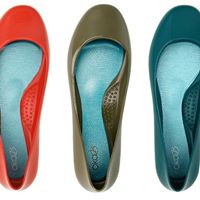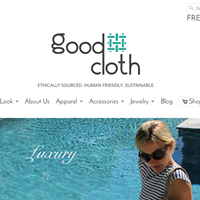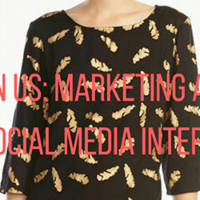Good Cloth specializes in ethical fashion—clothing, accessories, and home goods—that are designed with consideration for workers, the planet, and consumers. The shop curates products that are made with ethically-sourced materials and have a transparent supply chain. Style, workers’ rights, and the environment are the heart of Good Cloth. The company includes product journeys for each item, so that consumers can read how products are made, from beginning to end. How clothing is made shouldn’t be a mystery.
Good Cloth is founded by Stephanie Hepburn, an independent journalist and author of Human Trafficking Around the World: Hidden in Plain Sight. It was during Hepburn’s research that she began to vet designers for her own shopping needs and that of her family. She quickly learned that even the best intentioned larger companies ran into transparency hurdles. A contractor can subcontract and that subcontractor can do the same. Suddenly, there is no transparency and no way to assess how workers are treated throughout the supply chain. This creates an ideal opportunity for human trafficking. We don’t often connect the fashion industry with human trafficking, but exploitation that rises to human trafficking happens when industries are un-monitored or under-monitored, which is often the case in the fashion industry where there is low-cost entry into industrialization of poorer nations across the globe. Without sufficient monitoring, there is opportunity for unscrupulous people to step in and charge astronomical recruitment fees that place garment workers in debt bondage. That’s why materials in Good Cloth’s products have small, transparent supply chains, so that its well-intentioned designers can fulfill their sustainability missions.
It was the Rana Plaza collapse in 2013—the same year Hidden in Plain Sight came out and Hepburn began talks on human trafficking—that was the final impetus for Hepburn to found Good Cloth. The collapse made a significant, albeit brief, impact on the consumer conscience. People wanted to know how to shop ethically and how to determine if a product actually was what a designer claimed—ethical, sustainable, green, eco-friendly, or fair trade. With so many marketing terms and labels, shopping responsibly can be confusing. The goal at Good Cloth is to give a product’s entire journey so that the consumer can decide for himself/herself if it fits his/her ethos. The bar at Good Cloth is that each item is made (throughout it’s supply chain) in a way that is fair to workers and to the environment. Each item must be high quality, because it isn’t sustainable if it falls apart. Good Cloth also creates preferred shopping categorizes to make it easier for customers to shop by their own personal ethics—such as vegan, organic, shop local New Orleans (Good Cloth’s headquarters is in New Orleans), Trade Not Aid, handcrafted, and made in the United States. Customers can also shop by cost (low to high, high to low). Good Cloth wants to ensure that all consumers have access to ethically made products.
The reason we became a B Corp. Our attention spans are short, but generally we, as consumers, aim to do the right thing—as long as it’s convenient. That sounds cynical, we realize, but it’s true, and that’s why it’s essential that there are easy ways for consumers to purchase apparel and accessories that are ethically-sourced and have transparent supply chains—and that’s why we became a B Corp. We want to provide an easy-to-shop space where consumers can efficiently find items that are sustainable and fit their ethos, desired price range, and style aesthetic.Change isn’t easy. The more remote consumers believe the garment worker experience to be, the less he/she cares. That isn’t because consumers are cold-hearted, but instead that their lives are replete with demands on their time and energy. The sustainable fashion world is asking consumers to care about one more issue, one consumers likely perceive, incorrectly, to be out of their hands. Good Cloth hopes to inspire consumers to understand their purchasing power and the collective impact it can have to push the fashion industry toward progress. Consumers are Good Cloth’s partner to improve the lives of garment workers—the majority of whom are marginalized women living on the periphery or fully ostracized from society—one garment, accessory, or home good at a time.
Good Cloth also asks consumers to partner with them to support female designers. The vast majority of the company’s designers are women because Good Cloth’s founder believes in supporting and elevating women in leadership and entrepreneurial roles. This, she believes, helps to shift cultural and corporate mindsets and counters implicit bias, the type of bias that is outside an individual’s awareness or control and affects judgment and behavior. Implicit stereotypes and lack of female representation reinforce one another. Meaning, implicit stereotypes contribute to persistent gender gaps in leadership, design, and science (yes, there is science in fashion!). In many areas where implicit gender bias exists, so to do gender gaps. This doesn’t just affect how boys and men view girls and women and their capabilities but also how all people—including girls and women—view a girl or woman’s capabilities. This means that 51 percent of the population, girls and women, likely have implicit bias about themselves. That’s a problem. At Good Cloth, consumers vote with their purchasing power for positive change in the garment industry and for gender equality.
The fashion industry, specifically through fast fashion, adversely affected itself by creating low-cost consumer expectations that can’t be sustained, in more ways than one. At present, consumers will spend $4.95 on a coffee beverage yet expect a dress to cost $9.99. This doesn’t mean that consumers spend less on clothing. No, the amount Americans spend, annually, is roughly equivalent to the retail value of the U.S. coffee market, $48 billion. What is does mean is that quantity, keeping up with trends—a pressure created by the fashion industry, and disposability have become part-and-parcel of how Americans consume clothing. Because of this, it may seem impossible to shift the long-resistant fashion industry toward ethical sourcing and transparency with the purchase of a garment, but the power consumers hold should not be underestimated. Quite simply, fashion brands are dependent on consumers; they drive the industry. If consumers begin to demand ethical-sourcing and transparency by shopping where that is provided, then brands will listen—even if they don’t care about sustainability. Changes in consumer purchasing spark dialogue and media reaction, which, in turn, can trigger companies to make positive changes to preserve their reputations and maintain consumer appeal, drawing them to sign accords with external audits that require transparency, ethical sourcing, and fair rights for laborers. Good Cloth wants to be instrumental in offering high quality clothing and to partner with consumers to swing the pendulum in the entire fashion industry, not just a niche, toward transparency, ethical sourcing, fair treatment of workers, sustainability, and high quality.











